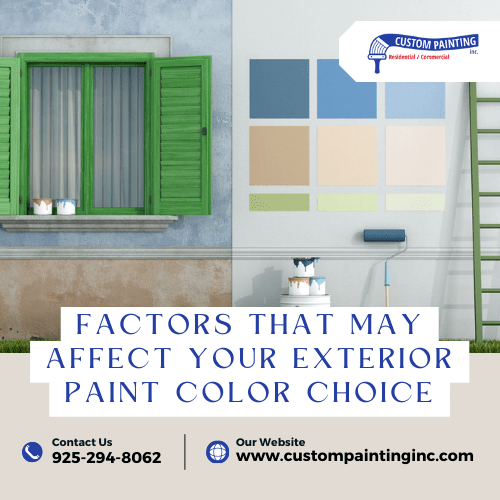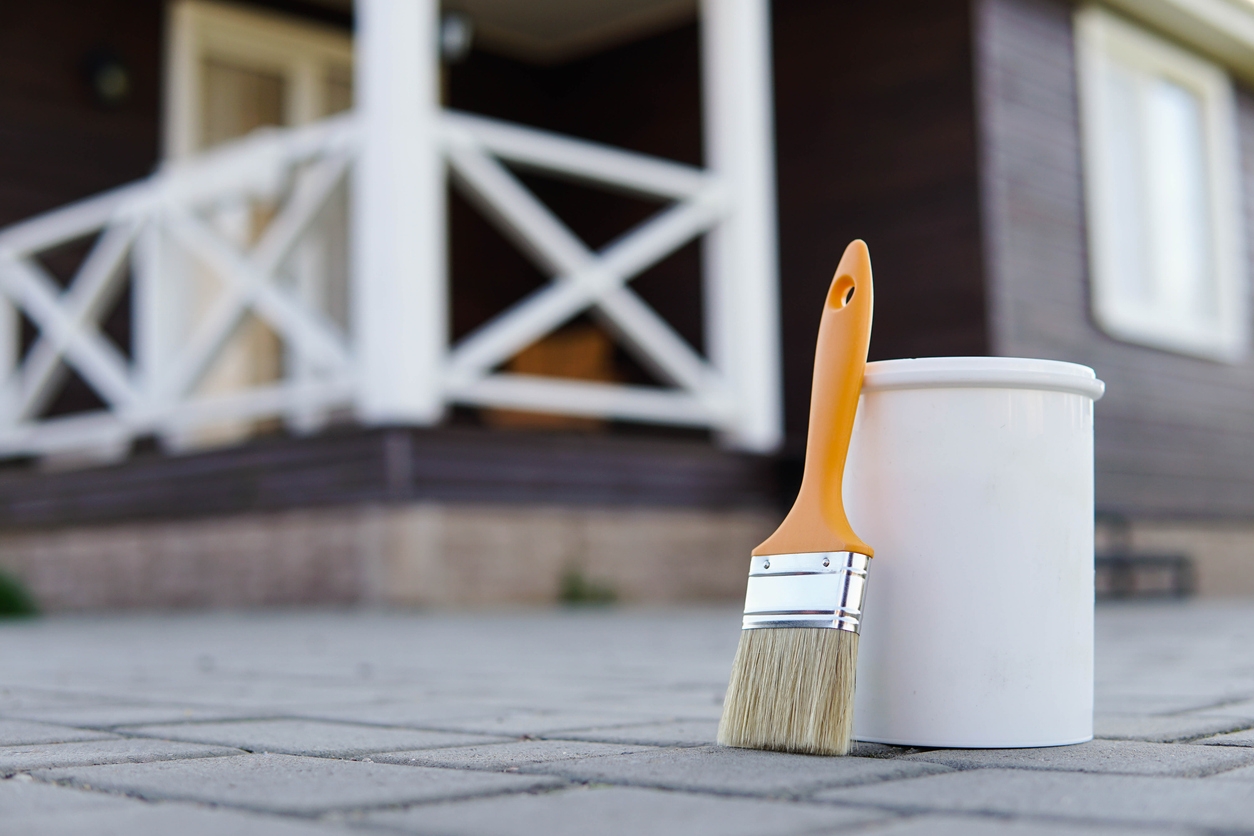Selecting the right exterior paint color for your home involves several considerations. The color you select not only affects your home’s appearance but also its overall feel and harmony with the surroundings. Read on to learn about the key factors that may influence your exterior paint color choice. Find the perfect palette for your home with professional color consulting for painting services.
Architectural Style
The architectural style of your home plays a major role in determining the best exterior paint color. Each style has its own set of characteristics and color palettes that work well with its design elements.
For example, a Victorian-style home often features bold and vibrant colors that highlight its intricate details and trim. In contrast, a Colonial-style home looks best with classic and muted colors, such as whites, grays, and blues, which reflect its traditional and timeless nature.
Understanding your home’s architectural style helps you choose colors that complement its structure and history. A modern home with clean lines and minimalistic features might benefit from sleek, neutral colors like black, white, or gray.
On the other hand, a Mediterranean-style home often uses earthy tones like terracotta, beige, and warm reds to blend with its natural surroundings. Matching the paint color to the architectural style enhances the overall look and feel of your home.
Neighborhood and Surroundings

When choosing an exterior paint color, it is also important to consider your neighborhood and surroundings. The environment around your home influences how certain colors will look and blend. Check below for the factors to think about when it comes to neighborhood and surroundings:
- Neighboring Homes: Look at the color schemes of nearby houses. Choosing a color that complements the neighboring homes helps create a harmonious street appearance.
- Natural Landscape: Consider the natural elements around your home, such as trees, gardens, and bodies of water. Colors that blend with these elements can enhance your home’s connection to its surroundings.
- Local Climate: The climate affects how colors appear. Bright sunlight can make colors look lighter, while overcast skies can make them appear darker. Choose colors that will look good in your local weather conditions.
- Historical Context: Some neighborhoods have historical significance with specific color schemes. Research the history of your area to ensure your color choice respects the traditional palette.
- Community Guidelines: Check if there are any homeowners’ association rules or community guidelines regarding exterior paint colors. This ensures that your choice complies with local regulations.
- Architectural Cohesion: Consider the overall architectural style of the neighborhood. Choosing colors that fit the general style of the area helps maintain visual cohesion and can even boost property values.
Climate and Weather Conditions
Climate and weather conditions have a role in your selection of the right exterior paint color for your home. The local climate affects how colors appear and how well they withstand the elements. Here are the factors to consider:
- Sunlight Exposure: Intense sunlight can fade bright colors quickly. Opt for lighter shades or UV-resistant paints in sunny areas to maintain color vibrancy.
- Temperature Fluctuations: Extreme temperature changes can cause paint to expand and contract, leading to cracks. Choose high-quality, flexible paints that can withstand these fluctuations.
- Humidity Levels: High humidity can cause paint to peel or blister. Look for paints specifically designed for humid climates to ensure durability.
- Rainfall and Moisture: In areas with heavy rainfall, moisture-resistant paints are essential. These paints prevent water damage and mold growth, keeping your home looking fresh.
- Wind Exposure: Wind can carry dust and debris that can wear down paint. Durable, high-performance paints help protect against these abrasive elements.
- Salt Air: Coastal areas with salty air can cause paint to deteriorate faster. Use paints formulated to resist salt corrosion for homes near the ocean.
- Snow and Ice: In colder climates, snow and ice can be harsh on exterior paint. Choose paints that offer strong adhesion and can withstand freezing temperatures to avoid peeling and cracking.
Personal Preference and Trends
Personal preference and trends are important factors when choosing an exterior paint color for your home. Your taste reflects your personality and style, so it is important to select a color you love. Trends also play a role, as they can influence your choices and keep your home looking modern and appealing.
Think about the colors you are naturally drawn to and how they make you feel. Some people prefer bold and vibrant colors, while others lean toward soft and neutral tones. Consider how the color will look on your home and whether it matches your vision.
Trends in exterior paint colors change over time, so it is helpful to stay updated on what is popular. Look at home design magazines, websites, and even your local area to see what colors are trending. This can give you inspiration and help you choose a color that feels current and stylish.
Material of the House Exterior
The material of your house exterior could also affect your choice of paint or colors. Different materials require different types of paint and preparation to achieve the best results. Read below for the common materials and considerations for each:
- Wood: Wood exteriors need paint that protects against moisture and rot. Use high-quality exterior latex paint for durability and a finish that allows the wood to breathe.
- Brick: Brick requires a breathable paint that prevents moisture buildup. Choose mineral-based or silicate paint for a long-lasting finish that adheres well to brick surfaces.
- Stucco: Stucco needs paint that can handle its porous nature and slight surface movements. Acrylic latex paint is a good option as it provides flexibility and durability.
- Vinyl Siding: Vinyl siding expands and contracts with temperature changes. Use paint specifically formulated for vinyl to ensure proper adhesion and flexibility.
- Metal: Metal exteriors, such as aluminum or steel, require paint that prevents rust and corrosion. Look for rust-inhibiting primers and topcoats for a durable and protective finish.
- Fiber Cement: Fiber cement siding is durable but still needs protection from the elements. Use 100% acrylic paint for a finish that resists cracking and peeling.
- Composite Materials: Composite siding materials need paint that adheres well to synthetic surfaces. Use high-quality exterior latex paint designed for composites to ensure longevity and a clean finish.
Practical Considerations
There are also practical factors to consider when choosing exterior paint. These factors help ensure that your choice is not only aesthetically pleasing but also functional and long-lasting. Check out these practical considerations to keep in mind:
- Maintenance: Lighter colors tend to show dirt and stains more easily, requiring more frequent cleaning. Darker colors may fade faster and need more touch-ups. Consider your willingness to maintain the chosen color.
- Heat Absorption: Dark colors absorb more heat, which can increase cooling costs in warm climates. Lighter colors reflect heat, keeping your home cooler. Choose a color that suits your climate and energy efficiency needs.
- Home Size: Light colors can make a small house appear larger, while dark colors can make a large house seem smaller. Consider how you want to visually impact the size of your home.
- Trim and Accents: Think about how the main color will look with your trim, shutters, and other accents. Complementary colors can enhance the overall appearance of your home.
- Longevity: High-quality paints last longer and look better over time. Investing in good paint and proper application can save money and effort in the long run.
- Local Regulations: Some neighborhoods have rules regarding exterior paint colors. Check any homeowners’ association guidelines or local regulations before making your final decision.
- Resale Value: Neutral and universally appealing colors can increase your home’s resale value. Bold or unconventional colors might not appeal to potential buyers.
- Personal Comfort: Choose a color that makes you feel comfortable and happy. Your home should be a reflection of your personal tastes and preferences.
- Environmental Impact: Consider using eco-friendly paints with low VOCs (volatile organic compounds) to reduce your environmental footprint and improve indoor air quality.
- Cost: Factor in the cost of the paint and the labor required for the job. Some colors may require more coats to achieve full coverage.
Conclusion
Choosing the right exterior paint color for your home involves many factors. Consider the architectural style, neighborhood, climate, and personal preferences. By taking these factors into account, you can select a color that enhances your home’s appearance and meets your needs.
For expert advice and professional painting services, contact Custom Painting, Inc. Call us at 925-294-8062 or fill out a Contact Form on our website. Serving the Bay area including the cities of Antioch, Blackhawk, Danville, Fremont and Livermore.


